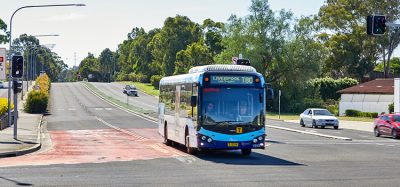Spotlight interview with Logpay’s Managing Director, Anne Grünkorn
- Like
- Digg
- Del
- Tumblr
- VKontakte
- Buffer
- Love This
- Odnoklassniki
- Meneame
- Blogger
- Amazon
- Yahoo Mail
- Gmail
- AOL
- Newsvine
- HackerNews
- Evernote
- MySpace
- Mail.ru
- Viadeo
- Line
- Comments
- Yummly
- SMS
- Viber
- Telegram
- Subscribe
- Skype
- Facebook Messenger
- Kakao
- LiveJournal
- Yammer
- Edgar
- Fintel
- Mix
- Instapaper
- Copy Link
Posted: 13 March 2019 | Intelligent Transport | No comments yet
Anne Grünkorn, Managing Director of LogPay Mobility Services, explains the benefits of working with a payment service provider that has a vast knowledge of multimodal transport systems.
EU legislation (Payment Service Directive I and II) for payment service providers via national financial authorities are constantly being updated, and rules on IT security are equally important. Payment service providers must be financially sound, and this should be one of the criterias an operator looks for in selecting a provider.
Secure payment processes are also key for passengers. There needs to be a balanced approach that ensures default risk for operators isn’t too high and that user-friendliness and high customer acceptance is maintained – a major challenge for payment service providers.
Processing micropayment transactions for digital goods in the very specialised sector of multimodal passenger transport also requires specialised IT systems that are flexible and customised to their needs. In each EU member state, and even within member states, the IT systems of operators and of other modes of transport have different architectures. They also use different software to make up their backbone systems. This results in various types of interfaces which payment service providers then have to link their system to. Interfaces need to be upgraded regularly due to technology developments and due to EU and national regulations, i.e. data protection. Changes to tariff systems, such as fixed-to-kilometre or time-based pricing, will also effect the payment process. Product-related parameters, from rental use of transport to sharing rides, adds to the complexity of payment solutions.
Functionality of mobile applications are based on real-time data transmission, but typical operator backbone systems are not based on real-time data exchange. Here, integration means seeing the whole picture and carefully checking the consequences of the IT landscape.
On top of this, any operator’s accounting system, or that of other mobility service providers, need to accurately receive purchase amounts, including applicable taxes which not only vary from EU member to EU member, but also between type of service – public transport versus private transport.
Setting up mobile apps for selling tickets or enabling access transport services such as car-sharing, ride-sharing or bike-sharing means navigating individual ecosystems that are complex in themselves. Mobility-as-a-Service allows users to switch from one mode to another, usually via a unified platform. However, each platform participant is its own legal entity and combining them adds to the aforementioned complexity.
We are seeing several promising regional approaches where local transport operators are building multimodal platforms according to the needs of their regional requirements.
Payments in transport are no longer linked exclusively to ticketing, with a number of new mobility services available – how has LogPay adapted to support these?
As a payment service provider, LogPay has vast experience in the transport sector across Europe. We serve all transport modes – railway, inland waterways and land transport for goods (B2B) as well as operators of passenger transport and other mobility service providers (B2C). We combine our understanding of the transport market environment with a deep knowledge of payment sector specifics.
We have built on our own IT system and flexible payment solution, which includes traditional payment means (e.g. credit and debit cards), with e-wallet payment means (i.e. PayPal and Amazon Pay) and mobile-integrated payment means (like Apple and Google Pay). We offer the whole service chain specifically adapted for this market: customised contract models, transaction processing, fraud prevention, risk management, settlement, clearing and customer support. LogPay combines today’s technology possibilities requiring constant innovation with rules and regulations with full-time dedication to our customers and partners.
How should public transport operators approach payments to ensure they continue modernising their offerings?
The most important thing for any operator is to understand its end users. While credit cards and debit cards are practically universal, outside of these methods there is a lot of variation in customer preferences. Today’s most-used payment method could be outmoded tomorrow. Working together with a payment service provider can help operators keep up to speed with the latest developments. LogPay’s next step is always driven by two things: the merchant and its customer.
What’s your view on Mobility-as-a-Service and the potential for payment systems to be integrated into one platform for all transport options?
Connecting different transport ecosystems through a platform approach works on a regional level and marks a significant change in the business approach of passenger transport operators. The success of these multimodal platforms partly relies on integration with public transport. Only by building on the efficient local public transport and shared mobility services can a MaaS system benefit society. The integration and clearing of payments is one of the most important factors in the success of MaaS, along with sharing customer data and finding new contract models.
Achieving MaaS across Europe starts with a shift in mindset. We should focus on mobility and movement instead of independent modes of transport without underestimating the complexity of developing such services. Above all, we must focus on the customer to deliver clean, safe, reliable and affordable multimodal transport services.
Related topics
Business Models, Infrastructure & Urban Planning, Multimodality, Passenger Accessibility, Ticketing & Payments
Issue
Issue 1 2019
Related organisations
LogPay Mobility Services
Related people
Anne Grünkorn








